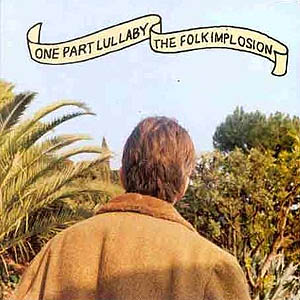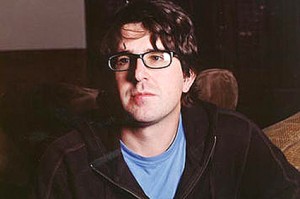FOREWORD: What happens to a side project that has a freakish hit single from a movie soundtrack? They break up when further success proves unattainable. Sebadoh lo-fi prince, Lou Barlow, began Folk Implosion with pen pal fan, John Davis, scoring big with the anodyne “Natural One” and then fading into underground obscurity.
I had interviewed John Davis after work at my Lodi, New Jersey office – which would be flooded with ten feet of water by the next morning. If I hadn’t taken the tape I recorded the phone conversation with back home that evening, this conversation would be lost forever. I may remember the problem with Davis was he didn’t want to tour. Since then, Barlow reestablished the Folk Implosion for ‘03s The New Folk Implosion (with three new members), but even I haven’t heard that comeback LP yet. This article originally appeared in Aquarian Weekly.
Getting together initially in 1988, four-track bedroom pioneer, Lou Barlow, and fellow Massachusetts native, John Davis, gained national attention as the Folk Implosion when narcotic ’95 mantra, “Natural One,” became a hit single from the Kids soundtrack. As a viable side project for Barlow, whose regular gig is co-fronting indie stalwarts, Sebadoh, Folk Implosion issued several limited edition lo-fi cassettes before boutique label, Communion Records, scooped up the duo for ambitious ’94 long-player, Take A Look Inside.
In ’97, the equally promising Dare to Be Surprised suppressed intentions for further commercial exposure with a set of relatively abstruse concoctions.
 Making good use of Pro Tool studio gear, Davis and Barlow recorded the impressive mood-shifting follow-up, One Part Lullaby for today’s finest major label, Interscope Records.
Making good use of Pro Tool studio gear, Davis and Barlow recorded the impressive mood-shifting follow-up, One Part Lullaby for today’s finest major label, Interscope Records.
From the hypnotic buzz of “My Ritual” to the feel good ‘60s spirit of “Back To The Sunrise,” One Part Lullaby revels in the sneering psychedelia of the creepy “No Need To Worry” and the horoscopic grandeur of the harmony-clad “Chained To The Moon.”
Barlow celebrates his current residency on “Easy L.A.,” then floats into the foggy mist with the transcendental “Mechanical Man.” The synthesized orchestral excursion, “Gravity,” takes the boys on a quantum journey beyond the realm of space and time while a fluid drum and bass groove filters through the acoustically centered “Someone You Love” and eerie instrumental “Serge.”
I spoke to Davis via phone from his Massachusetts home late September, 99.
How’d you hook up with Lou Barlow in’88?
JOHN: I got a hold of an early Sebadoh cassette through Conflict magazine. Iwas a big fan, wrote Lou a letter, and sent a tape. He was still in the band, Dinosaur. We developed a pen pal relationship.
Compare One Part Lullaby to Take A Lok Inside and the low-key Dare To Be Surprised.
JOHN: We had more time to work on the songs. Specific songs that grew out of past songs come to mind. You could go from “Palm Of My Hand” to “Pole Position” to “Free To Go,” or put “Someone You Love” next to “Take A Look Inside” and I’d know specific parts that led into each other. Obviously, there’s more programming on this record. The Kids soundtrack, because we recorded at home, actually used four-track recordings to make our own samples. We mixed them with higher-fi computer stuff. We try to mix and match different elements. There’s definitely a ‘70s studio pop vibe on the new album. When acoustic guitar and electronic synthesizers are put together, it makes me think of Fleetwood Mac.
How’d you initially get into music?
JOHN: I was born in 1970. My parents had Rumours and Cat Stevens albums. I don’t think it’s anything I listened to as a teenager, but it’s in my memory. I took folk guitar lessons for two years in sixth and seventh grade. Then I learned on my own by listening to records. I like Leo Kottke and John Fahey a lot. I also like standard ‘80s rockers like Peter Buck (R.E.M.), Thurston Moore (Sonic Youth), and the Feelies. I also like the simplicity of Steve Miller and AC/DC. I guess I try to combine art-rock with hard rock or obscure stuff. Jimmy Page did that for Led Zeppelin. He’d listen to the Blues, but was also into acoustic players like Bert Jansch.
Was it shocking when “Natural One” got played on commercial radio?
JOHN: We were in a unique position since we were staunchly indie and did the Kids soundtrack without signing a record contract. Certainly, we knew this stuff had commercial promise. We thought, ‘this should be played during a basketball game.’ There was a certain amount of innocent fun to it. But when it came time to decide how to finish Dare To Be Surprised, we wanted to protect what we had as an organic team, instead of becoming a hit-making machine. We’ve done a good job steering clear of that situation.
Does a lot of pre-arranging go on while making a Folk Implosion song?
JOHN: Hardly any. We build from bass and guitar, then add layers of percussion. We’ve learned through trial and error that making fewer plans before recording makes things catchier. I could take what’s spontaneous and dynamic and let Lou interact. Pro Tools allowed us to record on a computer without the tinny sound of DAT (Digital Audio Tape). It has better frequency response. It’s like word processing for sound. You could cut and pastethings and make tracks longer. We couldn’t do that on four-track. We’re overdubbing odds and ends and nonstandard instruments after the initial guitar-bass-drum parts. On “Free To Go,” there’s a part Lou played with a half-full glass of water tuned to the pitch of the song.
“Free To Go” seems influenced by hip-hop with its heavy bottom end.
JOHN: The bass line is very important to it. I don’t know where it falls. The guitar part is rockier than “My Ritual” and “Easy L.A,” but then we put in so many rhythm tracks for fun. Lou’s a great bass player and we let him step out on this record. The bass holds down the chord changes, but it’s cool to use for melodic purposes. As a guitarist, it allows me to play lines that are less busy and more sparse.
What new bands interest you?
JOHN: I like Quasi, Belle & Sebastian, and the last Sleater-Kinney record. I like Timbaland’s production, especially with Missy Elliott. I enjoy Jay Z’s “Can I Get A…” and I’m not above saying Beck’s really great. The Beastie Boys’ Hello Nasty was their best in nine years. It’s diffuse. But I’m not into the Beasties punky stuff. That doesn’t wash with me. I’ve been on an older music kick for the last year. I’ve been into Sun RA and Cecil Taylor and older Jazz by Duke Ellington, Jelly Roll Morton, and Count Basie. I like the Secret Museum Of Mankind indie folk collection of ethnic 78 RPM recodings from faraway places like Madagascar and Poland done in the ‘20s. It’s not pretentious Peter Gabriel world music.
One Part Lullaby has two very viable smart-pop contenders in “Chained To The Moon” and “Back To The Sunrise.” Do they stand a chance on watered down radio?
JOHN: I can’t stand listening to the radio. It’s a pretty bleak landscape. It’s difficult for musicians to carve out a lasting identity if they worry about what radio wants. People think there aren’t as many good bands now as there were before. Maybe iut has to dso with culture instead of a general lack of good stuff. There was a window of opportunity for different, cool songs around the time of “Natural One.’ There’s more of a backlash against creative rock on radio now. It’s weird to compare substantial ‘80s stars like Madonna, Prince, and Bruce Springsteen to fake ‘90s non-musicians like the Backstreet Boys and Britney Spears.

